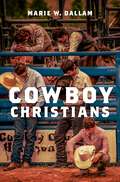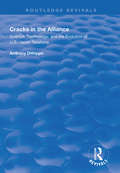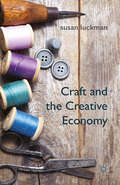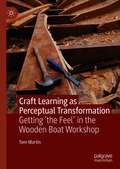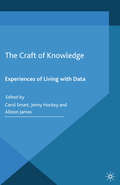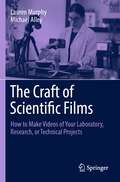- Table View
- List View
Cowboy Christians
by Marie W. DallamCowboy Christians examines the long history of cowboy Christianity in the American West, with a focus on the present-day cowboy church movement. Based on five years of historical and sociological fieldwork in cowboy Christian communities, this book draws on interviews with leaders of cowboy churches, traveling rodeo ministries, and chaplains who serve horse racing and bull riding communities, along with the author's first-hand experiences as a participant observer. Marie W. Dallam traces cowboy Christianity from the postbellum period into the twenty-first century, looking at religious life among cowboys on the range as well as its representation in popular imagery and the media. She examines the structure, theology, and perpetuation of the modern cowboy church, and speculates on future challenges the institution may face, such as the relegation of women to subordinate participant roles at a time of increasing gender equality in the larger society. She also explores the cowboy Christian proclivity for blending the secular and the sacred in leisure environments like arenas, racetracks, and rodeos. Dallam locates the modern cowboy church as a descendant of the muscular Christianity movement, the Jesus movement, and new paradigm church methodology. Cowboy Christians establishes the religious significance of the cowboy church movement, particularly relative to twenty-first-century evangelical Protestantism, and contributes to a deeper understanding of the unique Christianity of the American West.
Cowboy Christians
by Marie W. DallamCowboy Christians examines the long history of cowboy Christianity in the American West, with a focus on the present-day cowboy church movement. Based on five years of historical and sociological fieldwork in cowboy Christian communities, this book draws on interviews with leaders of cowboy churches, traveling rodeo ministries, and chaplains who serve horse racing and bull riding communities, along with the author's first-hand experiences as a participant observer. Marie W. Dallam traces cowboy Christianity from the postbellum period into the twenty-first century, looking at religious life among cowboys on the range as well as its representation in popular imagery and the media. She examines the structure, theology, and perpetuation of the modern cowboy church, and speculates on future challenges the institution may face, such as the relegation of women to subordinate participant roles at a time of increasing gender equality in the larger society. She also explores the cowboy Christian proclivity for blending the secular and the sacred in leisure environments like arenas, racetracks, and rodeos. Dallam locates the modern cowboy church as a descendant of the muscular Christianity movement, the Jesus movement, and new paradigm church methodology. Cowboy Christians establishes the religious significance of the cowboy church movement, particularly relative to twenty-first-century evangelical Protestantism, and contributes to a deeper understanding of the unique Christianity of the American West.
Coworking als Revolution der Arbeitswelt: von Corporate Coworking bis zu Workation
by Simon WertherDieses Buch „Coworking als Revolution der Arbeitswelt – von Corporate Coworking bis zu Workation” erklärt Ihnen das moderne Arbeits- und Lebenskonzept Coworking. Dabei reichen die Perspektiven von Corporate Coworking innerhalb von Firmen über Coworking Spaces im ländlichen Raum bis hin zu Workation als Kombination aus Coworking und Urlaub.Im Zentrum des Buchs stehen fundierte Perspektiven sowie umfassende Erfahrungsberichte von Expertinnen und Experten aus Hochschulen, Coworking Spaces und Verbänden. Sie erfahren somit nicht nur was Coworking wirklich auszeichnet, sondern auch welche Vorteile und Besonderheiten, aber auch welche Stolpersteine, damit einhergehen.Zielgruppen: Coworking und Workation ist von besonderer Bedeutung für alle, die sich beruflich mit modernen Arbeits- und Lebenskonzepten wie New Work auseinandersetzen, u.a. Personalverantwortliche, Kommunalvertreter, Geschäftsführer, Vorstandsmitglieder, Studierende und Hochschullehrende. Zum Herausgeber: Prof. Dr. Simon Werther ist an der Hochschule München als Professor für Leadership tätig. Er beschäftigt sich mit Führung im Wandel, New Work und modernen Arbeits- und Lebensformen wie Coworking und Workation. Darüber hinaus ist er Mitgründer des Münchner Startups HRinstruments, das digitale Feedbacktools entwickelt.
Coworking-Atmosphären: Zum Zusammenspiel von kuratierten Räumen und der Sicht der Coworkenden als raumhandelnde Subjekte
by Alexandra BernhardtDie Studie von Alexandra Bernhardt beschäftigt sich mit Coworking Spaces und ihren Atmosphären. Neben einer umfassenden Betrachtung der Rolle von Atmosphären wird die besondere Bedeutung von Gemeinschaft im Kontext dieser Arbeitsräume näher beleuchtet. Den Kern der Untersuchung bilden zwei Fallstudien in urbanen Coworking Spaces, wobei ein an der Ethnografie orientiertes, methodenplurales qualitatives Forschungsdesign verfolgt wird. Im Rahmen der Analyse wird zum einen betrachtet, was Coworking im Alltag und damit die neue Gemeinschaftlichkeit bei der Arbeit ausmacht: Dabei werden relevante Praktiken und Rituale, räumliche Arrangements und Atmosphären in ihrer Komposition herausgearbeitet. Zum anderen rücken die Coworkenden, ihr Raumhandeln und damit verbundene Haltungen näher in den Blick: Es wird aufgezeigt, wie sich die Nutzer*innen Coworking Spaces als Arbeits- und Gemeinschaftsräume erschließen und welche Rolle Atmosphären spielen. Zudem werden soziale Gebilde herausgestellt, die von den Coworkenden in Bezug auf ihren Coworking Space aufgegriffen werden und die den Coworking-Space-Alltag mitprägen. Auch werden Spannungen aufgedeckt, die aus einem Nebeneinander von Gemeinschafts- und Dienstleistungslogik entstehen, und der Umgang damit näher betrachtet.
Coworking Atmospheres: On the Interplay of Curated Spaces and the View of Coworkers as Space-acting Subjects
by Alexandra BernhardtThe study by Alexandra Bernhardt deals with coworking spaces and their atmospheres. In addition to a comprehensive consideration of the role of atmospheres, the special significance of community in the context of these work spaces is examined in more detail. Two case studies in urban coworking spaces form the core of the investigation, following a qualitative research design oriented towards ethnography and a plurality of methods. In the context of the analysis, on the one hand, what constitutes coworking in everyday life and thus the new communality at work is considered: relevant practices and rituals, spatial arrangements and atmospheres are elaborated in their composition. On the other hand, coworkers, their spatial actions, and the attitudes associated with them come into closer focus: It is shown how users access coworking spaces as work and community spaces and what role atmospheres play. In addition, social entities are highlighted that are taken up by coworkers in relation to their coworking space and that help shape everyday coworking space life. Tensions that arise from the coexistence of community and service logic are also uncovered, and how they are dealt with is examined in more detail.
The Coworking (R)evolution: Working and Living in New Territories
The digitalization of work processes and the generalization of IT are creating unprecedented opportunities. An increasing part of the workforce is experimenting with new forms of work, as freelancers, self-employed or highly skilled employees with greater autonomy. International in scope, this book comprehensively explores these new models of work, mobility and life trajectories, and the increasing role of non-metropolitan coworking spaces.This interdisciplinary book investigates new trends in relationships between work, life plans, work-life balance, and mobility in the context of ongoing societal digitalization. An expert group of contributors adopts a comparative approach in assessing the coworking phenomenon. They examine the social embeddedness of collaborative workspaces and consider topics such as social exchange, cooperation, and collaboration, critically assessing the question of individual and collective mobilities, and exploring the historical roots of coworking and its developing meanings and uses in practice.Gathering a wide variety of studies which investigate the diversity of social trajectories, institutional context, social transition, cooperation, policy measures, and mobility patterns, this book will be an interesting read for academics and students in the fields of organizational behavior, human geography, sociology of work, cities, and regional studies. Politicians interested in territorial development, elected officials, workers of municipalities and regions, and journalists who cover work issues, will similarly find this to be a beneficial read.
Coworking Spaces: Alternative Topologies and Transformative Potentials
by Janet Merkel Dimitris Pettas Vasilis AvdikosThis contributed volume considers the emergence of coworking as centered in labor issues. More specifically, its chapters consider it as a coping mechanism in the worldwide rise of independent modes of work (i.e., self-employment) that leaves more and more workers exposed to precarity as they must organize and manage their own labor. Grounded in this perspective, this volume aims to understand the transformative social and political potentials emerging through coworking as a social and spatial practice. There is a distinct lack of discussion within coworking research on the emancipatory potentials of coworking—and if it is discussed, more cautionary views prevail, highlighting the ambivalence of coworking spaces both as a space of alternative economic practices and as integrated into market economies. The aims of this collection are twofold: First, it aims to make visible the plurality of existing practices around shared resources in coworking and the assemblages of human and non-human actors as agents of change associated with coworking and the re-organization of work and labor power. And second, it aims to develop a more emancipatory narrative for coworking and the role of coworking spaces for workers but also the different spatial contexts in which these spaces are situated. A narrative that does not emphasize entrepreneurship or coworking as the epitome of the ‘neoliberal entrepreneurial self’ as in the dominant interpretations in the current research, but rather one that centers coworking in the creation of meaningful, careful social relationships, supporting empathy and an ethics that recognizes mutual interdependencies and builds a foundation for social change. So, it is about alternative narratives, emancipation politics and the wider social role that coworking spaces might play in neighborhoods, cities or beyond because they are crucial contexts for the formation and maintenance of social relations. With this specific direction, this collection aims to bring coworking research into a fruitful dialog with other research fields-such as sociology of work, feminist perspectives on care, alternative and diverse economies, "post-capitalist" transformation, critical geography, positioning coworking within a range of progressive alternatives in the articulation of economic and social relationships.
The Cracked Art World: Conflict, Austerity, and Community Arts in Northern Ireland (Material Mediations: People and Things in a World of Movement #12)
by Kayla RushThis book presents a nuanced view of Northern Ireland, a place at once deeply mired in its past and seeking to forge a new future for itself as a ‘post-post-conflict’ place within the context of a changing United Kingdom, a disintegrating Europe, and a globalized world. This is a Northern Ireland that is conflicted, segregated, and marginalized within modern Europe, but also hopeful and forward looking, seeking to articulate for itself a new place in the contemporary world.
Cracking the IT Architect Interview
by Sameer ParadkarThe ultimate guide to successful interviews for Enterprise, Business, Domain, Solution, and Technical Architect roles as well as IT Advisory Consultant and Software Designer roles About This Book • Learn about Enterprise Architects IT strategy and NFR – this book provides you with methodologies, best practices, and frameworks to ace your interview • A holistic view of key architectural skills and competencies with 500+ questions that cover 12 domains • 100+ diagrams depicting scenarios, models, and methodologies designed to help you prepare for your interview Who This Book Is For This book is for aspiring enterprise, business, domain, solution, and technical architects. It is also ideal for IT advisory consultants and IT designers who wish to interview for such a role. Interviewers will be able leverage this book to make sure they hire candidates with the right competencies to meet the role requirements. What You Will Learn • Learn about IT strategies, NFR, methodologies, best practices, and frameworks to ace your interview • Get a holistic view of key concepts, design principles, and patterns related to evangelizing web and Java enterprise applications • Discover interview preparation guidelines through case studies • Use this as a reference guide for adopting best practices, standards, and design guidelines • Get a better understanding with 60+ diagrams depicting various scenarios, models, and methodologies • Benefit from coverage of all architecture domains including EA (Business, Data, Infrastructure, and Application), SA, integration, NFRs, security, and SOA, with extended coverage from IT strategies to the NFR domain In Detail An architect attends multiple interviews for jobs or projects during the course of his or her career. This book is an interview resource created for designers, consultants, technical, solution, domain, enterprise, and chief architects to help them perform well in interview discussions and launch a successful career. The book begins by providing descriptions of architecture skills and competencies that cover the 12 key domains, including 350+ questions relating to these domains. The goal of this book is to cover all the core architectural domains. From an architect's perspective, it is impossible to revise or learn about all these key areas without a good reference guide – this book is the solution. It shares experiences, learning, insights, and proven methodologies that will benefit practitioners, SMEs, and aspirants in the long run. This book will help you tackle the NFR domain, which is a key aspect pertaining to architecting applications. It typically takes years to understand the core concepts, fundamentals, patterns, and principles related to architecture and designs. This book is a goldmine for the typical questions asked during an interview and will help prepare you for success! Style and approach This book will help you prepare for interviews for architectural profiles by providing likely questions, explanations, and expected answers. It is an insight-rich guide that will help you develop strategic, tactical, and operational thinking for your interview.
Cracks in the Alliance: Science, Technology and the Evolution of U.S.-Japan Relations (Routledge Revivals)
by Anthony DiFilippoPublished in 1997. Providing an analysis of the science and technology policies of the United States and Japan, this book shows how these policies have led to different market outcomes. It looks at the extent of unfair trade practised by Japan, and its efforts to craft a global post-Cold War position for itself.
Cracks in the Alliance: Science, Technology and the Evolution of U.S.-Japan Relations (Routledge Revivals)
by Anthony DiFilippoPublished in 1997. Providing an analysis of the science and technology policies of the United States and Japan, this book shows how these policies have led to different market outcomes. It looks at the extent of unfair trade practised by Japan, and its efforts to craft a global post-Cold War position for itself.
Cradle to Grave: Life-Course Change in Modern Sweden
by Jan O. Jonsson Colin MillsThe empirical study of individuals' life-course is one of the most promising areas of research within sociology today. Increased availability of large-scale longitudinal data and improved statistical methods have made it possible to address theoretically relevant questions about events such as entrance into the labour market, job mobility, divorce and death. This book consists of studies capturing the life-course from the cradle to the grave. The research questions include long-term consequences of childhood conditions; family formation and school-careers; work and parental leave; gender discrimination in job promotion; divorce and occupational career; persistence in poverty; and the intriguing question of why the highly educated tend to survive everyone else. The studies shed light on the relation between family and work, on gender inequality, social class differences, welfare state redistribution, and labour market processes. They do this in a particular context, namely Sweden in the post-war period that is, during the decades that formed one of the most advanced welfare states in modern history. One chapter provides a descriptive account of institutional and life-course change in Sweden during that period. Most authors use the Swedish level-of-living surveys, a unique data set providing ample opportunity to study social processes in a longitudinal perspective. The book will, therefore, be of relevance to those with interests in the Swedish welfare state as well as those with theoretical and reseacrh interests in the reproduction of inequality
Cradle to Grave: Life-Course Change in Modern Sweden
by Jan O. Jonsson Colin MillsThe empirical study of individuals' life-course is one of the most promising areas of research within sociology today. Increased availability of large-scale longitudinal data and improved statistical methods have made it possible to address theoretically relevant questions about events such as entrance into the labour market, job mobility, divorce and death. This book consists of studies capturing the life-course from the cradle to the grave. The research questions include long-term consequences of childhood conditions; family formation and school-careers; work and parental leave; gender discrimination in job promotion; divorce and occupational career; persistence in poverty; and the intriguing question of why the highly educated tend to survive everyone else. The studies shed light on the relation between family and work, on gender inequality, social class differences, welfare state redistribution, and labour market processes. They do this in a particular context, namely Sweden in the post-war period that is, during the decades that formed one of the most advanced welfare states in modern history. One chapter provides a descriptive account of institutional and life-course change in Sweden during that period. Most authors use the Swedish level-of-living surveys, a unique data set providing ample opportunity to study social processes in a longitudinal perspective. The book will, therefore, be of relevance to those with interests in the Swedish welfare state as well as those with theoretical and reseacrh interests in the reproduction of inequality
Craft and the Creative Economy
by S. LuckmanCraft and the Creative Economy examines the place of craft and making in the contemporary cultural economy, with a distinctive focus on the ways in which this creative sector is growing exponentially as a result of online shopfronts and home-based micro-enterprise, 'mumpreneurialism' and downshifting, and renewed demand for the handmade.
Craft Beverages and Tourism, Volume 1: The Rise of Breweries and Distilleries in the United States
by Carol Kline Susan L. Slocum Christina T. CavaliereThis two-volume set examines the strong connection between craft beverages and tourism, presenting cutting-edge research in partnership with breweries, distilleries, and cideries. While wine, food, and culinary tourism have traditionally dominated destination markets, interest in craft beverages has gained momentum across the US and overseas with local markets quickly recognizing the growing craft beverage movement. Through the eyes of tourism scholars, brewers, and travelers, these two volumes explore the landscape of craft beer opportunities in non-traditional settings, and recognize the potential for future economic, socio-cultural, and environmental sustainability. Craft Beverages and Tourism, Volume 1: The Rise of Breweries and Distilleries in the United States is an inclusive and overarching examination of the US craft beverage phenomenon within a larger context of international beverage tourism. It outlines the current practice and research scope of craft beer, cider, and spirits as well as the sustainable development of destinations revolving around craft beverage. Through literature reviews, case studies, and general exploration, this volume advances marketing, hospitality, and leisure studies research for academics, industry experts, and emerging entrepreneurs.
Craft Beverages and Tourism, Volume 1: The Rise of Breweries and Distilleries in the United States
by Carol Kline Susan L. Slocum Christina T. CavaliereThis two-volume set examines the strong connection between craft beverages and tourism, presenting cutting-edge research in partnership with breweries, distilleries, and cideries. While wine, food, and culinary tourism have traditionally dominated destination markets, interest in craft beverages has gained momentum across the US and overseas with local markets quickly recognizing the growing craft beverage movement. Through the eyes of tourism scholars, brewers, and travelers, these two volumes explore the landscape of craft beer opportunities in non-traditional settings, and recognize the potential for future economic, socio-cultural, and environmental sustainability. Craft Beverages and Tourism, Volume 1: The Rise of Breweries and Distilleries in the United States is an inclusive and overarching examination of the US craft beverage phenomenon within a larger context of international beverage tourism. It outlines the current practice and research scope of craft beer, cider, and spirits as well as the sustainable development of destinations revolving around craft beverage. Through literature reviews, case studies, and general exploration, this volume advances marketing, hospitality, and leisure studies research for academics, industry experts, and emerging entrepreneurs.
Craft Beverages and Tourism, Volume 2: Environmental, Societal, and Marketing Implications
by Susan L. Slocum, Carol Kline and Christina T. CavaliereThis volume applies a mix of qualitative and quantitative research and case studies to analyze the role that the craft beverage industry plays within society at large. It targets important themes such as environmental conservation and social responsibility, as well as the psychology of the craft beer drinker and their impact on tourism marketing. This volume advances marketing, hospitality, and leisure studies research for academics, industry experts, and emerging entrepreneurs.
Craft in Biomedical Research: The iPS Cell Technology and the Future of Stem Cell Science
by Mianna MeskusThis book explores the new ways in which biology is becoming technology. The revolutionary iPS cell technology has made it possible to turn human skin and blood cells into pluripotent stem cells, thus providing an unprecedented opportunity to study the pathophysiology of diseases, understand human developmental biology, and generate new therapies. Drawing from a rich ethnographic study, Meskus traces the making of the iPS cell technology through the perspectives of clinical translation, laboratory experimentation, and tissue donation by voluntary patients. Discussing non-human agency, the embodied and affective basis of knowledge production, and the material politics of science, the book develops the idea of an instrumentality-care continuum as a fundamental dynamic of biomedical craft. This continuum, Meskus argues, opens up a novel perspective to the commercialization and industrial-scale appropriation of human biology, and thereby to the future of ethical biomedical research.
Craft Learning as Perceptual Transformation: Getting ‘the Feel’ in the Wooden Boat Workshop
by Tom MartinThrough an examination of three wooden boat workshops on the East coast of the United States, this volume explores how craftspeople interpret their tools and materials during work, and how such perception fits into a holistic conception of practical skill. The author bases his findings on first-person fieldwork as a boat builder’s apprentice, during which he recorded his changing sensory experience as he learned the basics of the trade. The book reveals how experience in the workshop allows craftspeople to draw new meaning from their senses, constituting meaningful objects through perception that are invisible to the casual observer. Ultimately, the author argues that this kind of perceptual understanding demonstrates a fundamental mode of human cognition, an intelligence frequently overlooked within contemporary education.
The Craft of College Teaching: A Practical Guide
by Robert DiYanni Anton BorstThe essential how-to guide to successful college teaching and learningThe college classroom is a place where students have the opportunity to be transformed and inspired through learning—but teachers need to understand how students actually learn. Robert DiYanni and Anton Borst provide an accessible, hands-on guide to the craft of college teaching, giving instructors the practical tools they need to help students achieve not only academic success but also meaningful learning to last a lifetime.The Craft of College Teaching explains what to teach—emphasizing concepts and their relationships, not just isolated facts—as well as how to teach using active learning strategies that engage students through problems, case studies and scenarios, and practice reinforced by constructive feedback. The book tells how to motivate students, run productive discussions, create engaging lectures, use technology effectively, and much more. Interludes between chapters illustrate common challenges, including what to do on the first and last days of class and how to deal with student embarrassment, manage group work, and mentor students effectively. There are also plenty of questions and activities at the end of each chapter.Blending the latest research with practical techniques that really work, this easy-to-use guide draws on DiYanni and Borst's experience as professors, faculty consultants, and workshop leaders. Proven in the classroom and the workshop arena, The Craft of College Teaching is an essential resource for new instructors and seasoned pros alike.
The Craft of Creativity
by Matthew A. Cronin Jeffrey LoewensteinCreativity has long been thought of as a personal trait, a gift bestowed on some and unachievable by others. While we laud the products of creativity, the stories behind them are often abridged to the elusive "aha!" moment, the result of a momentary stroke of genius. In The Craft of Creativity Matthew A. Cronin and Jeffrey Loewenstein present a new way to understand how we innovate. They emphasize the importance of the journey and reveal the limitations of focusing on outcomes. Drawing on a wide range of scholarship, their own research, and interviews with professionals and learners who employ creativity in the arts, engineering, business, and more, Cronin and Loewenstein argue that creativity is a cognitive process that hinges on changing one's perspective. It's a skill that anyone can hone, and one that benefits from thinking with others and over time. Breaking new ground in the discussion about how we innovate, this book provides strategies that everyone can use to be more creative.
The Craft of Information Visualization: Readings and Reflections (Interactive Technologies)
by Ben Shneiderman Benjamin B. BedersonSince the beginning of the computer age, researchers from many disciplines have sought to facilitate people's use of computers and to provide ways for scientists to make sense of the immense quantities of data coming out of them. One gainful result of these efforts has been the field of information visualization, whose technology is increasingly applied in scientific research, digital libraries, data mining, financial data analysis, market studies, manufacturing production control, and data discovery.This book collects 38 of the key papers on information visualization from a leading and prominent research lab, the University of Maryland’s Human-Computer Interaction Lab (HCIL). Celebrating HCIL’s 20th anniversary, this book presents a coherent body of work from a respected community that has had many success stories with its research and commercial spin-offs. Each chapter contains an introduction specifically written for this volume by two leading HCI researchers, to describe the connections among those papers and reveal HCIL’s individual approach to developing innovations.*Presents key ideas, novel interfaces, and major applications of information visualization tools, embedded in inspirational prototypes.*Techniques can be widely applied in scientific research, digital libraries, data mining, financial data analysis, business market studies, manufacturing production control, drug discovery, and genomic studies.*Provides an "insider" view to the scientific process and evolution of innovation, as told by the researchers themselves.*This work comes from the prominent and high profile University of Maryland's Human Computer Interaction Lab
The Craft of Knowledge: Experiences of Living with Data
by Allison James Carol Smart Jenny HockeyThis book is a contribution to contemporary debates on social research with a unique focus on the relationship between methods and the crafting of knowledge. Nine experienced researchers from different disciplines have come together to explore what really matters to them in the process of doing qualitative research.
The Craft of Scientific Films: How to Make Videos of Your Laboratory, Research, or Technical Projects
by Lauren Murphy Michael AlleyThis book, the first of its kind, helps scientists and engineers of all stages and disciplines share their work in a new way—with movies. Today, much of scientific communication is embedded in papers and presentations, but these documents don’t often extend outside of a specific academic field. By adding movies as a medium of communication, scientists and engineers can better communicate with their colleagues while also increasing their reach to students, professors, peers, potential collaborators, and the public. Scientific films help translate complex technical topics into more accessible and consumable messages. By following Lauren Murphy’s filmmaking formula – planning, shooting, and editing – readers will create their very own scientific films that look professional and polished. Using tools as simple as a smartphone, readers can develop short, personal stories with no cost or experience needed. This book will guide readers through all steps of the movie making process to a finished product. Readers will evolve their creative thinking skills and use their movies to improve classroom presentations, network across student organizations, present at conferences, recruit students for their labs, secure grant money, and more. Adding a movie to your body of work can be the tool that sparks interest in audiences to learn more—driving traffic to your publications, research projects, and websites. This book will help you develop new skills to become a better communicator while spreading your ideas and research to new audiences.
The Craft of Social Anthropology
by A.L. EpsteinIn social anthropology, as in other branches of science, there is a close relationship between research methods and theoretical problems. Advancing theory and shifts in orientation go hand in hand with the development of techniques and mutually influence one another. If the development of modern social anthropology owes much to its established tradition of fieldwork, it is also clear that the procedures that anthropological fieldwork should follow in the laboratory can never be prescribed in absolute terms nor become wholly standardized. Yet as anthropological analysis is refined, it becomes increasingly important that students in the field be aware of the need to collect basic kinds of data, and know how to set about doing so. In this volume, anthropologists who have worked closely together for many years at the Rhodes- Livingstone Institute for Social Research, Lusaka, and/or in the Department of Social Anthropology, University of Manchester, discuss within a common framework modern fieldwork methods as tools for examining a number of problems of current anthropological interest. Elizabeth Colson, J. Clyde Mitchell, and J. A. Barnes stress aspects of the role of quantification in social anthropology and indicate a range of problems that can be illuminated by the use of quantitative techniques. Equal importance is attached by all contributors to the collection and analysis of detailed case material, a topic explored in J. van Velsen's essay. A. L. and T. S. Epstein, V. W. Turner, and M. G. Marwick consider the kinds of data relevant to anthropological discussion in the fields of economics, law, ritual, and witchcraft, and the methods by which such material may be collected. The volume is introduced by Max Gluckman, former director of the Rhodes-Livingstone Institute and former head of the department of social anthropology and sociology, University of Manchester.
